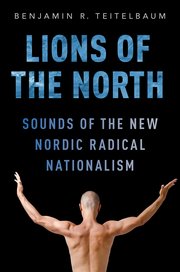
 This is part of our special feature on Nationalism, Nativism, and the Revolt Against Globalization.
This is part of our special feature on Nationalism, Nativism, and the Revolt Against Globalization.
In Lions of the North, Benjamin Teitelbaum addresses one of the most challenging issues of our time: the re-emergence of radical nationalism. Based on long-term ethnographic fieldwork amongst neo-nationalist activists in the Nordic countries, Teitelbaum analyzes the role of nationalist music in processes of recruitment, belonging, and mainstreaming. This is a groundbreaking and compelling book for several reasons. Despite the substantial and growing number of analyses of the so-called new nationalism, few studies are grounded in ethnographic inquiry. While macro-studies highlight the structural conditions and motives for large segments of populations, we know less about neo-nationalist engagements in everyday life. The rather few ethnographic studies of radical nationalists is hardly surprising. Few scholars want to invest the considerable time or establish the ties necessary for the ethnographic study of people who might expose values they do not necessarily share (Blee 2007:121). However, in the age of Trumpism, Brexit, and Le Pen, understanding people who strongly oppose many of the ideas championed in liberal democracies is of great importance.
Teitelbaum’s long-term engagement and rich ethnography amongst radical nationalists in the Nordic countries is thus a rare and remarkable achievement. Highlighting his personal attraction to the field, as an American, half-Jewish scholar with Swedish relatives, Teitelbaum transforms his youth fascination with one of the most liberal societies in the world to engaged scholarship. Mastering Swedish, he managed to gain entry and conduct fieldwork over several years with white neo-nationalists in the Nordic region in general, and Sweden in particular. While not denying the threat and actuality of violent imaginaries associated with some of these actors, Teitelbaum strives to go beyond reductionist and simplistic terminology, such as “extremists.” He notes that by calling radical nationalists “extremists” or “deviant,” we might “be declaring ourselves privy to an ultimate reality-some particular state of heterogeneity and ambiguity inherent in the human condition-of which they are ignorant” (7). Teitelbaum sets out on an open-minded quest to understand his interlocutors, rather than undermining their cause. He takes their fears, grievances, and concerns seriously without trivializing or denying the harmful effect of their racist and xenophobic resentments. Whatever the hatreds he finds, Teitelbaum makes clear that he befriended some of the people he met, at times enjoying the hospitality and time he spent with them. The role of being an empathic listener—yet critical researcher—can be a difficult balancing act. Yet it is precisely Teitelbaum’s deep and respectful engagement with the field of research that makes this a captivating book.
Combining critical discourses with multi-sited ethnographic fieldwork, Teitlebaum gathers striking empirical knowledge on the role of music and expressive culture in reconfiguring neo-nationalist thought and action. The book is rigorously constructed, yet refreshing to read. Teitelbaum divides the Nordic neo-nationalist scene into three distinct and interrelated categories: race revolutionaries, cultural nationalist, and identitarians. Despite their great differences, what unites these ideological strands is their resistance to immigration and multiculturalism, all of which they believe threaten the imagined purity of a national people. Lyrics and musical styles are used to rally against the alleged enemies of the nation—liberals and non-native others—as well to redraw the ethnic, racialized and religious boundaries of the nation and Western civilization. National music nurtures nostalgia for a golden past of bio-racial purity that is allegedly threatened by rapid cultural and demographic change. Some lyrics contain imaginaries of national-racial rebirth, while others call for violent revolution or defense of a nation betrayed by the cosmopolitan, liberal establishment that strives to deny or erase national difference. Action is commonly justified by conspiratorial thinking of an undiluted nation threated by Jews, Marxists, and Islamists.
Based on personal conversations with dozens of activists, ranging from members of the Sweden Democrats to white nationalists in Vigrid, he shows that neo-nationalist thought and practice are not static but constantly adjusting to new societal developments and technologies. Examining transformation in musical styles, imagery, and aesthetics, Teitelbaum reveals their ideological and expressive ambiguities, constrictions and (in)consistencies across time and space. Neo-nationalist activists are eclectically synthesizing elements from different ideologies, traditions, and musical genres in local, regional, and national resistance to immigration, liberalism, and multiculturalism. While the neo-nationalist activists claim to protect the ethno-cultural purity of the nation, the notion of pure music genres are nevertheless difficult to maintain in the globalized era. Some of the neo-nationalists even tolerate a degree of cosmopolitanism in music that they reject in other domains. The paradox is evident: the actors protesting ethno-racial mixing are using the very tools of globalization in reconfiguring both their musical taste and ideology.
Through in depth ethnographic observation and analysis, Teitelbaum examines the instrumental role of music in campaigns of reform. Neo-nationalists use multiple music genres- from folk music and Viking rock to rap, reggae, and hip-hop, to nurture passions and to reinvent themselves as the reformed, yet righteous defenders of a nation under threat. The populist party Sweden Democrats, that is currently polling above twenty percent, has in particular appropriated folk music as part of a strategy to soften their image and appear as respectable members of mainstream society. The party tries to distance itself from its skinhead past to focus on a more inclusive nationalism celebrating Swedish cultural heritage. Teitelbaum also analyzes the concerns and role of female singers, such as the star of white power music, Saga, in attracting a wider, global audience to neo-nationalist activism. Yet as Teitelbaum’s analysis shows, most attempts to reform and integrate with the mainstream appear alongside calls to withdraw into particularism and promote the uniqueness of a distinct people, a process he terms the New Nationalist double imperative.
Exploring crucial, yet often overlooked dimensions of neo-nationalism through the lens of music—such as its emotional, embodied, and gendered components—Lions of the North is a significant contribution to scholarship. The exceptionally well-written and nuanced book sheds unique light on musical politics. It is essential reading for all who want to better understand the rise, character, and appeal of radical nationalism in the Nordic countries and beyond.
Reviewed by Cathrine Thorleifsson, University of Oslo
Lions of the North: Sounds of the New Nordic Radical Nationalism
by Benjamin R. Teitelbaum
Publisher: Oxford University Press
Hardcover / 232 pages / 2017
ISBN: 9780190212605
To read more book reviews, please click here.
Published on February 1, 2018.
References:
Blee, Kathleen M. 2007. “Ethnographies of the far right.” Journal of Contemporary Ethnography 36.2: 119-128.




